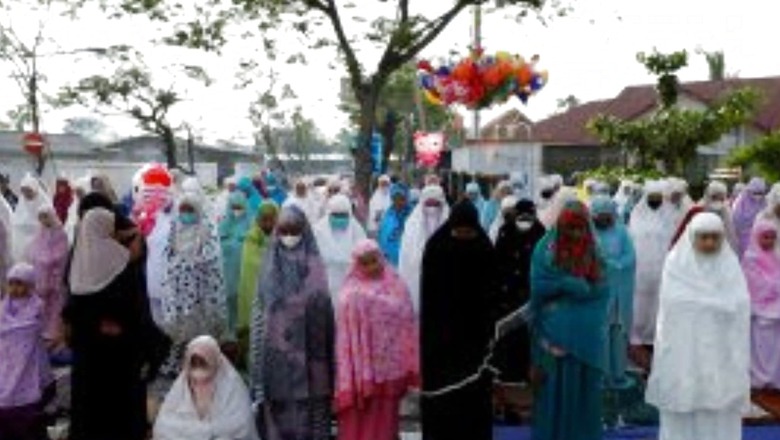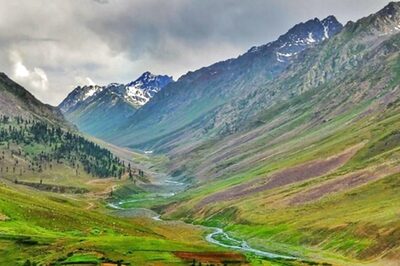
views
Indonesia is a country with which India has had relations dating back millennia. The country is one of India’s maritime neighbours and is a strategic partner today, thanks to its vast geographic expanse from Banda Aceh, just a few hundred miles south of the Indira Point in India’s Andaman & Nicobar Islands, all the way to the island of Guinea, just north of the Australian territories of Northern Australia and Queensland. However, due to the stability in the relationship between the two countries, Indonesia hardly features in popular discussions domestically. Nevertheless, it is essential to look at Indonesia as a country that has gone beyond its Islamic identity to embrace its Hindu past and to the Muslims of the Indian subcontinent, it has many lessons to offer. Although of late there has been a rise in radical Islamist elements, Indonesia has been able to thwart any such radical outfits from threatening the broader and tolerant Indonesian society.
Indonesia has had Hindu influence for more than two millennia now, with the religion and cultural practices arriving with trade. Hinduism encountered the local Javanese and Balinese religions in the region, leading to the emergence of a syncretic culture in the Indonesian Islands, even under the Srivijaya and Majapahit empires. However, with the decline of these empires and the arrival of Islam, Hinduism got restricted to a few pockets, especially on the island of Bali, which has the largest Hindu population of more than 4 million in Indonesia.
Although Indonesia today remains the largest Islamic country in the world, Hinduism’s influence in the society is immense. Hinduism finds place in the cultural ethos of the land and Hindu gods are still vastly revered in Indonesia. Both Ramayana and Mahabharata have a special place in the hearts of Indonesians and are viewed as sacred scriptures. Evidence for this can be found in the form of the magnificent Arjuna Wijaya chariot statue and fountain in Central Jakarta. The statue depicts a Mahabharata epic with Sri Krishna riding the chariot with Arjuna holding, who is wielding a bow and arrow, while the chariot is being pulled by eleven horses.
In the case of Ramayana, one of the most common female names in Indonesia even today are “Siti” (noble virtuous woman) and “Dewi” (Goddess). Apart from epics, ancient Indonesian site excavations show how Shiva Lingam and its worship were commonplace in the Indonesian archipelago. Apart from Shiva, Parvati, Ganesh, Kartikeya idols have also been excavated. Even today, in Hindu majority Bali, the island’s major temple called Prambanan temple demands a must visit, to get a glimpse into the Hindu way of life in Indonesia.
The Hindu influence in Indonesia is far from over. Indonesia’s national air carrier is named Garuda Indonesia, after the mythical bird from Hindu scripture, called “Garuda”. A majority Islamic country with a flag carrier named after Garuda! Even as the debate in India rages on post Arvind Kejriwal’s suggestion of introducing the images of Hindu gods and goddesses, Indonesian 20,000 Rupiah banknotes already sport the picture of Ganesha.
The reverence for the Sanskrit language in Indonesia is immense and the word “Bahasa” for the Indonesian language comes from the word Bhasha. Sanskrit lines used as “Motto” are used by various government organisations. For example,
i) Indonesia National Police: Rastra Sewakottama (Serving the Nation)
ii) Indonesian National Armed Forces: Tri Dharma Eka Karma (‘Three services, one determination’)
iii) Indonesian Army: Kartika Eka Paksi (‘Unmatchable Bird with Noble Goals’)
iv) Indonesian Navy: Jalesveva Jayamahe (‘Victorious on the Sea’)
v) Indonesian Air Force: Swa Bhuwana Paksa (‘Wings of the Motherland’)
Many Indonesians, irrespective of their religion, use Hindu names such as Wisnu, Surya, Indra, Arya, Putra, Aditya, Sita, etc. This is very unique especially given the country is known to be the home to world’s largest number of followers of Islam. Indonesia is showing the world a path away from radicalised and violent Islam. Countries like Pakistan, Bangladesh, etc, which were once homes to Hinduism and Sanatana Dharma are today far removed from it. What is worse is how even in India, the vast majority of followers of Islam do not identify themselves with the ancient civilisational ethos of India. How can Aftab meaning ‘Sun’ find adoption so easily by practitioners of Islam in India, while the word ‘Aditya’ with the same meaning cannot? How is ‘Fatah’ okay while ‘Vijay’ is not?
These questions are indicative of the deep generational brainwashing and deracination of the common Muslim in India. Just a few generations ago, the ancestors of most Indian Muslims must have been undoubtedly Hindu. However, for various reasons including fear for life under the Islamist tyrants have resulted in a situation where they inhabit a land, whose ethos they are not even aware of. Nehruvian secularism post-Independence has further kept them away from the mainstream. A Punjabi Hindu up North will not have any problem visiting a Hindu temple in Tamil Nadu and will coexist with Hindus from other parts of India, without any issue. But a Punjabi Muslim in Pakistan and a Bengali Muslim from Bangladesh cannot coexist with Punjabi Hindus and Bengalis Hindus. This is precisely where the crux of the issue lies.
Time has come for Indian Muslims realise how they have been manipulated by so-called secular politicians for decades to be kept deliberately away from joining the larger mainstream of Indian society. These divisions are becoming starker, thanks to social media and propaganda-filled content from across the border. More importantly, it is necessary to break the mullah nexus for Indian Muslims to be liberated from the clutches of the clergy.
Indonesia, a neighbouring Islamic country with its respect for diversity, tolerance and cultural roots based in Hindu ethos, shines as a beacon of hope. After all, India is from where these unique ideas made their way to the Indonesian Islands. It is high time Indian Muslims learnt from their Indonesian counterparts and contributed positively to the development of India.
Zeba Zoriah writes on politics, policies, culture and women’s rights. The views expressed in this article are those of the author and do not represent the stand of this publication.
Read all the Latest Opinions here



















Comments
0 comment